UNITED STATES
SECURITIES AND EXCHANGE COMMISSION
Washington, D.C. 20549
FORM N-CSR
CERTIFIED SHAREHOLDER REPORT OF REGISTERED
MANAGEMENT INVESTMENT COMPANIES
Investment Company Act File Number: 811-02958
| T. Rowe Price International Funds, Inc. |
| (Exact name of registrant as specified in charter) |
| 100 East Pratt Street, Baltimore, MD 21202 |
| (Address of principal executive offices) |
| David Oestreicher |
| 100 East Pratt Street, Baltimore, MD 21202 |
| (Name and address of agent for service) |
Registrant’s telephone number, including area code: (410) 345-2000
Date of fiscal year end: October 31
Date of reporting period: October 31, 2021
 |
| China Evolution Equity Fund | October 31, 2021 |
| TCELX | Investor Class |
| TRCLX | I Class |
| T. ROWE PRICE China Evolution Equity Fund |
HIGHLIGHTS
| ■ | The fund generated a strong return and significantly outperformed its benchmark in the 12-month period ended October 31, 2021. |
| ■ | Our overweight position and stock selection in industrials and business services contributed to performance, as did our choice of securities in the consumer discretionary sector. Conversely, stock selection in consumer staples and materials was unfavorable, and our underweight in materials also held back gains. |
| ■ | The fund’s largest overweight position is in the industrials and business services sector. Its biggest sector underweight holdings are in financials and communication services. |
| ■ | Regulatory policies targeted at education, property, health care, and online platforms may lead to volatility—however, we believe the government’s intention is not to derail the private sector but to promote more sustainable growth. Long-term outcomes could be improved if the government can balance better equity with preserving entrepreneurship. The drive for common prosperity and fair competition could also serve as a tailwind for small and medium-sized businesses. |
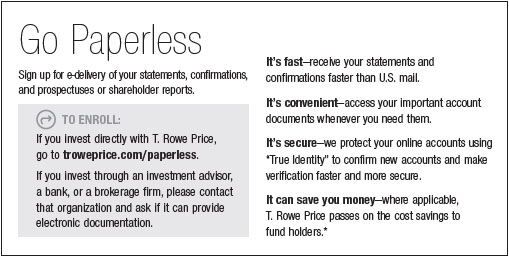
Log in to your account at troweprice.com for more information.
*Certain mutual fund accounts that are assessed an annual account service fee can also save money by switching to e-delivery.
CIO Market Commentary
Dear Shareholder
Global stock markets produced strong returns during your fund’s fiscal year, the 12-month period ended October 31, 2021. The rollout of coronavirus vaccines helped drive extraordinary gains in the first half of the reporting period, and while the equity rally slowed in recent months, some benchmarks continued to grind out new record highs as the period came to an end.
In the U.S., the S&P 500 Index was up 43% (including dividends) for the 12-month period, and most developed market benchmarks advanced more than 30%. Emerging markets produced solid results for the full year but faced increased volatility in the second half of the period. According to MSCI, value stocks narrowly outperformed their growth counterparts over the 12 months. At the sector level, energy stocks delivered very strong returns as oil prices reached multiyear highs, and banks also performed well, supported by higher longer-term interest rates and improved lending margins.
Fixed income markets faced headwinds as Treasury yields rose rapidly in the first quarter of 2021 from the historically low levels seen last year, although high yield bonds performed well. Meanwhile, the U.S. dollar was mixed against foreign currencies over the full year.
Strong corporate earnings growth supported stocks and corporate bonds throughout the period, but investors faced new worries as the period progressed. The spread of the delta variant of the coronavirus dashed hopes that vaccines would bring about a quick end to the pandemic, and economic growth, while still positive, began to slow. U.S. gross domestic product decelerated from a 6.7% annual pace in the second quarter to 2.0% in the third quarter (according to the initial estimate) amid weaker consumer spending. Some Purchasing Managers’ Indexes showed evidence of slowing economic activity globally.
Investors also worried about how developments in China would impact the global economy. The Chinese government announced more stringent business regulations during the period, particularly on the technology sector, and the precarious debt load of a large property developer added to market concerns.
Meanwhile, inflation surged as the release of pent-up demand and supply chain disruptions contributed to higher prices around the globe. Inflation measures in the U.S., UK, and eurozone all reached their highest levels in more than a decade and far exceeded central bank targets, although most policymakers argued that elevated inflation was a transitory phenomenon caused by the reopening of economies.
The fiscal and monetary stimulus that global governments and central banks enacted in response to the pandemic continued to be supportive for markets but appears to have peaked. Just after our reporting period ended, the Federal Reserve announced it would begin trimming its purchases of Treasury bonds and mortgage-backed securities in November and would likely wrap up its asset purchases by next summer. The Fed’s latest projections indicated that a rate hike isn’t likely until the second half of next year at the earliest, but other central banks have begun telegraphing that rate hikes could come soon.
How markets respond to the normalization of monetary policy is an open question. While fading stimulus might pose some challenges for investors, I believe it could contribute to a return of price sensitivity in global markets, which bodes well for selective investors focused on fundamentals.
While I do not expect robust overall equity returns in the near term given the market’s elevated valuations, I am mindful that investors have not yet enjoyed all the potential fruits of the recovery. Many companies have yet to see business return to pre-pandemic levels, and identifying which ones are either regaining their footing or disrupting markets through innovation will be key. I’m confident our portfolio managers and global research organization will serve our investors well in this environment.
Thank you for your continued confidence in T. Rowe Price.
Sincerely,

Robert Sharps
Group Chief Investment Officer
Management’s Discussion of Fund Performance
INVESTMENT OBJECTIVE
The fund seeks long-term growth of capital.
FUND COMMENTARY
How did the fund perform in the past 12 months?
The China Evolution Equity Fund returned 18.22% in the 12-month period ended October 31, 2021. The fund significantly outperformed the MSCI China All Shares Index Net. (Returns for the I Class shares varied slightly, reflecting a different fee structure. Past performance cannot guarantee future results.)
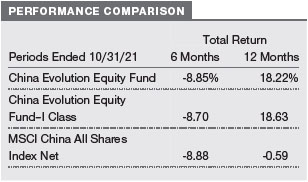
What factors influenced the fund’s performance?
Our overweight position and stock selection in industrials and business services added the most to relative performance. We believe the prospects for an increase in clean energy investments are one factor lending support to this cyclical sector.
Shares of NARI Technology, an equipment maker for power grids, gained. The company benefits from more government investment to upgrade power grids for purposes of better forecasting electricity demand and redistributing supply. NARI Technology is part of the potential solution to alleviate power shortages and can help make power transmission more efficient. Shipping logistics company SITC International was another top contributor. Its share price performance has been strong, supported by the solid end demand for goods. (Please refer to the portfolio of investments for a complete list of holdings and the amount each represents in the portfolio.)
Our choice of securities in the consumer discretionary sector boosted relative performance. Zhejiang Shuanghuan Driveline, which produces and sells gears and shafts, was among the top contributors. We believe it stands to benefit as electric vehicles (EVs) gain share against traditional cars, as it is a dominant player in making gearboxes for EVs. Our holding in Li Ning also added. The leading domestic sportswear company reported strong financial results, driven by an improved product offering and Chinese consumers’ growing preference for local brands. The government’s pledge to promote sports among citizens serves as another tailwind.
In contrast, our choice of stocks in the consumer staples sector was unfavorable. Yifeng Pharmacy Chain, an operator of a network of over 5,000 offline pharmacies, detracted from performance. Its shares were subject to profit taking after reaching multiyear highs in the first quarter on strong results that showed better-than-expected sales of non-pharmaceutical products. The company has continued to expand despite the coronavirus pandemic, demonstrates effective expense control, and has seen profitability steadily improve. Shares in China Feihe, a leading infant formula maker, suffered amid concerns about China’s declining birth rate and changing population dynamics. We retain high conviction in the company due to its strong fundamentals and potential to capture market share from foreign competitors.
The materials sector was strong over the year, due to favorable supply and demand conditions. However, we were unable to capture these gains given our underweight sector exposure, while stock selection also detracted. We have not been able to find many attractive ideas in this sector, partly due to environmental, social, and governance concerns.
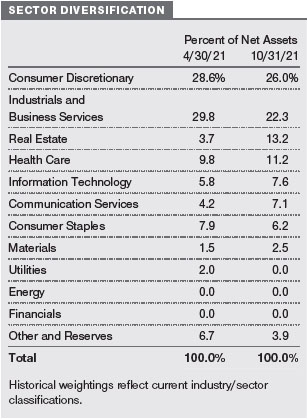
The biggest stock-level detractor was New Oriental Education & Technology, which we sold in July. Shares of the leader in private tutoring slumped after the government announced its new after-school tutoring policy, which effectively undermines the sector’s commercial business model.
How is the fund positioned?
We seek to invest in companies overlooked by most investors in China, going beyond the top 100 largest companies in the China universe by market cap to identify future performers. Our focus is on identifying quality companies, beyond the widely owned mega-cap stocks, that potentially offer durable growth that can compound over multiple years; accelerating growth from a new product or industry cycle; or special situation opportunities as we look beyond short-term challenges or concerns to the longer-term prospects of the company.
As a result, the fund’s largest overweight position is in the industrials and business services sector. Its biggest sector underweight holdings are in financials and communication services.
We retain our conviction in property management companies; in our view, they are on the right side of change as they can help improve living conditions. For example, property management company Country Garden Services Holdings (CGS) is a sizable holding. Despite the firm’s profits surging in the first half of the year, its shares fell amid concerns that the property sector, which is already facing policy headwinds, may see further tightening. We added to our position on weakness, and our view on the stock remains positive. The company has grown its market share through acquisitions as weaker competitors had to sell their operations and raise cash during the sell-off linked to indebted property company China Evergrande (to which the portfolio has had no exposure). CGS is also expanding into urban and third-party residential services to enlarge its addressable market.
We increased our overweight in the industrials and business services sector. We believe this cyclical sector should be well placed to perform strongly as China strives to achieve self-sufficiency. We established a position in Shenzhen Megmeet Electrical, a supplier of industrial power sources, industrial automation products, and electric control products for smart home appliances. The firm has accelerated its production capacity expansion, research and development, and team building with the aim of realizing its 2025 revenue target of RMB 12 billion. We believe new product launches should mark the start of a chapter of steady, long-term growth for the company.
We scaled back our overweight position in the consumer discretionary sector, reducing our exposure to education companies. We sold our holdings in New Oriental Education & Technology, as mentioned earlier, and TAL Education following the introduction of harsh new regulations for the after-school tutoring sector that caught many investors off guard. We have always sought to keep the size of our positions in the education space in check, so the overall impact on the portfolio of the government’s regulatory crackdown has been well contained.
What is portfolio management’s outlook?
While investors have focused on China’s regulatory actions, Beijing’s long-term agenda has remained consistent: to build a more sustainable and equitable society. China has experienced multiple regulatory cycles in the past, and many of these have been countercyclical, with structural reform undertaken when the economic situation is strong. We believe the impact of these has been to make China’s economy more resilient to external shocks.
Regulatory policies targeted at education, property, health care, and online platforms may lead to volatility—however, we believe the government’s intention is not to derail the private sector but to promote more sustainable growth. We believe long-term outcomes could be improved if the government can balance better equity with preserving entrepreneurship. The drive for common prosperity and fair competition could also serve as a tailwind for small and medium-sized businesses.
China offers more than 5,000 companies listed worldwide, but not all are affected by regulations in the same way. History and past experience inform us that the market as a whole tends to grow stronger after each round of regulation, and more new businesses emerge. China remains, in our opinion, a fertile hunting ground for investors who seek sustainable businesses with strong balance sheets and future winners using bottom-up fundamental research.
The views expressed reflect the opinions of T. Rowe Price as of the date of this report and are subject to change based on changes in market, economic, or other conditions. These views are not intended to be a forecast of future events and are no guarantee of future results.
RISKS OF INVESTING IN GREATER CHINA
The Chinese economy is generally considered an emerging and volatile market. A small number of companies represent a large portion of the China market as a whole, and prices for securities of these companies may be very sensitive to adverse political, economic, or regulatory developments in China and other Asian countries and may experience significant losses in such conditions. China’s central government has historically exercised substantial control over the Chinese economy through administrative regulation and/or state ownership.
RISKS OF INTERNATIONAL INVESTING
Investments outside the U.S. may lose value because of declining foreign currencies or adverse political or economic events overseas, among other things. Securities of non-U.S. issuers (including depositary receipts and other instruments that represent interests in a non-U.S. issuer) tend to be more volatile than U.S. securities and are subject to trading markets with lower overall liquidity, governmental interference, and regulatory and accounting standards and settlement practices that differ from the U.S.
The fund could experience losses based solely on the weakness of foreign currencies in which the fund’s holdings are denominated versus the U.S. dollar and changes in the exchange rates between such currencies and the U.S. dollar. Risks can result from differing regulatory environments, less stringent investor protections, uncertain tax laws, and higher transaction costs compared with U.S. markets. Investments outside the U.S. could be subject to governmental actions, such as capital or currency controls, nationalization of a company or industry, expropriation of assets, or imposition of high taxes.
RISKS OF NONDIVERSIFICATION
Because the fund is nondiversified and thus can invest more of its assets in a smaller number of issuers, it is more exposed to the risks associated with an individual issuer than a fund that invests more broadly across many issuers. For example, poor performance by a single large holding of the fund would adversely affect the fund’s performance more than if the fund were invested in a larger number of issuers.
For a more thorough discussion of risks, please see the fund’s prospectus.
BENCHMARK INFORMATION
Note: MSCI makes no express or implied warranties or representations and shall have no liability whatsoever with respect to any MSCI data contained herein. The MSCI data may not be further redistributed or used as a basis for other indices or any securities or financial products. This report is not approved, reviewed, or produced by MSCI.
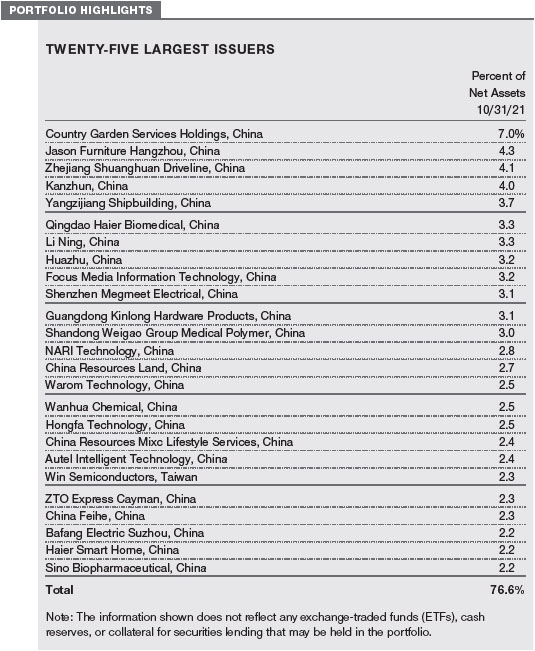
GROWTH OF $10,000
This chart shows the value of a hypothetical $10,000 investment in the fund over the past 10 fiscal year periods or since inception (for funds lacking 10-year records). The result is compared with benchmarks, which include a broad-based market index and may also include a peer group average or index. Market indexes do not include expenses, which are deducted from fund returns as well as mutual fund averages and indexes.
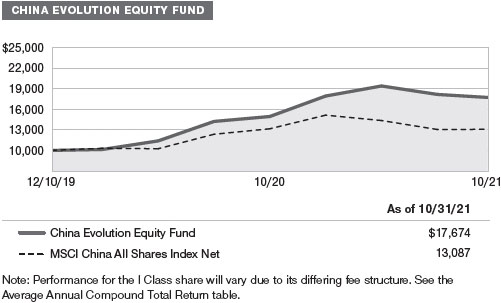
AVERAGE ANNUAL COMPOUND TOTAL RETURN
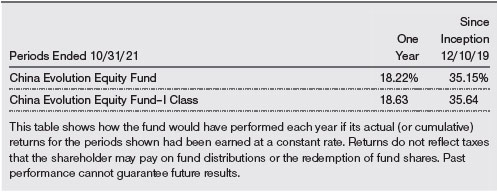
EXPENSE RATIO

FUND EXPENSE EXAMPLE
As a mutual fund shareholder, you may incur two types of costs: (1) transaction costs, such as redemption fees or sales loads, and (2) ongoing costs, including management fees, distribution and service (12b-1) fees, and other fund expenses. The following example is intended to help you understand your ongoing costs (in dollars) of investing in the fund and to compare these costs with the ongoing costs of investing in other mutual funds. The example is based on an investment of $1,000 invested at the beginning of the most recent six-month period and held for the entire period.
Please note that the fund has two share classes: The original share class (Investor Class) charges no distribution and service (12b-1) fee, and the I Class shares are also available to institutionally oriented clients and impose no 12b-1 or administrative fee payment. Each share class is presented separately in the table.
Actual Expenses
The first line of the following table (Actual) provides information about actual account values and expenses based on the fund’s actual returns. You may use the information on this line, together with your account balance, to estimate the expenses that you paid over the period. Simply divide your account value by $1,000 (for example, an $8,600 account value divided by $1,000 = 8.6), then multiply the result by the number on the first line under the heading “Expenses Paid During Period” to estimate the expenses you paid on your account during this period.
Hypothetical Example for Comparison Purposes
The information on the second line of the table (Hypothetical) is based on hypothetical account values and expenses derived from the fund’s actual expense ratio and an assumed 5% per year rate of return before expenses (not the fund’s actual return). You may compare the ongoing costs of investing in the fund with other funds by contrasting this 5% hypothetical example and the 5% hypothetical examples that appear in the shareholder reports of the other funds. The hypothetical account values and expenses may not be used to estimate the actual ending account balance or expenses you paid for the period.
Note: T. Rowe Price charges an annual account service fee of $20, generally for accounts with less than $10,000. The fee is waived for any investor whose T. Rowe Price mutual fund accounts total $50,000 or more; accounts electing to receive electronic delivery of account statements, transaction confirmations, prospectuses, and shareholder reports; or accounts of an investor who is a T. Rowe Price Personal Services or Enhanced Personal Services client (enrollment in these programs generally requires T. Rowe Price assets of at least $250,000). This fee is not included in the accompanying table. If you are subject to the fee, keep it in mind when you are estimating the ongoing expenses of investing in the fund and when comparing the expenses of this fund with other funds.
You should also be aware that the expenses shown in the table highlight only your ongoing costs and do not reflect any transaction costs, such as redemption fees or sales loads. Therefore, the second line of the table is useful in comparing ongoing costs only and will not help you determine the relative total costs of owning different funds. To the extent a fund charges transaction costs, however, the total cost of owning that fund is higher.

QUARTER-END RETURNS
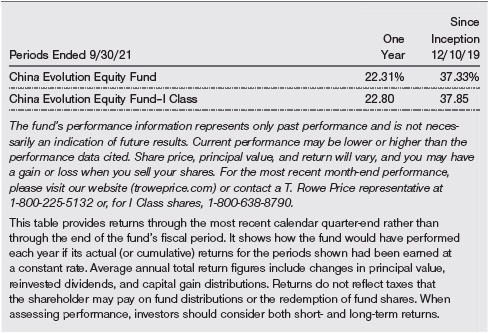
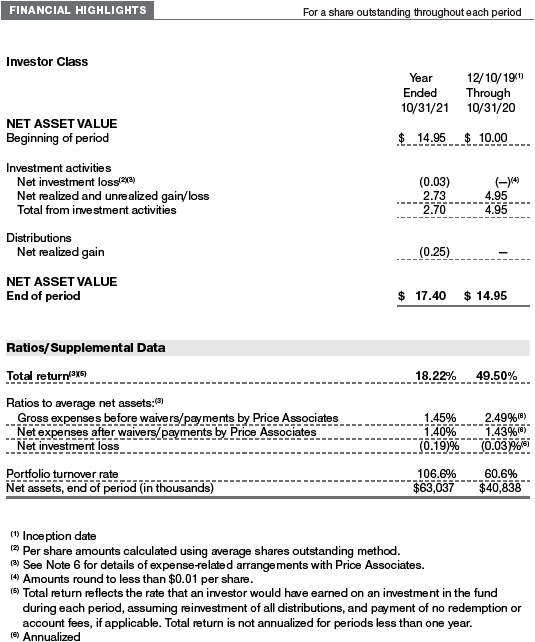
The accompanying notes are an integral part of these financial statements.
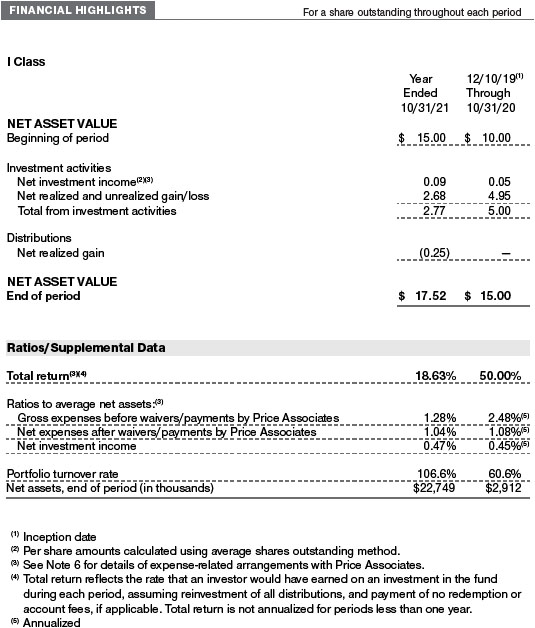
The accompanying notes are an integral part of these financial statements.
October 31, 2021
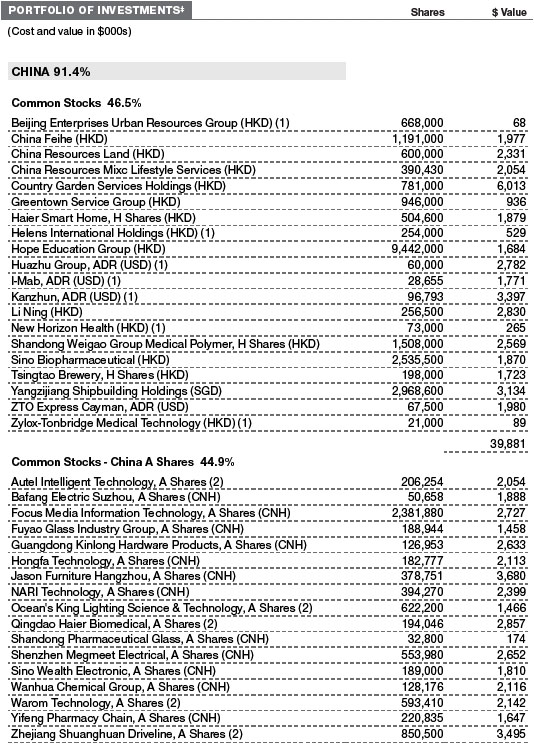
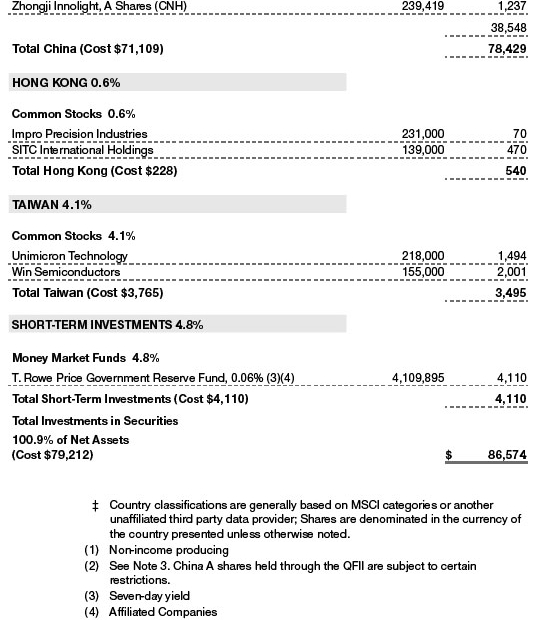

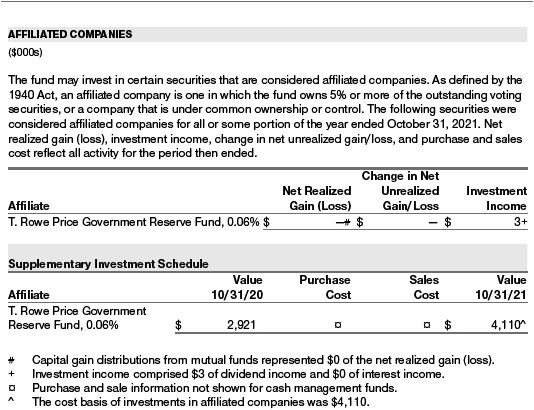
The accompanying notes are an integral part of these financial statements.
October 31, 2021
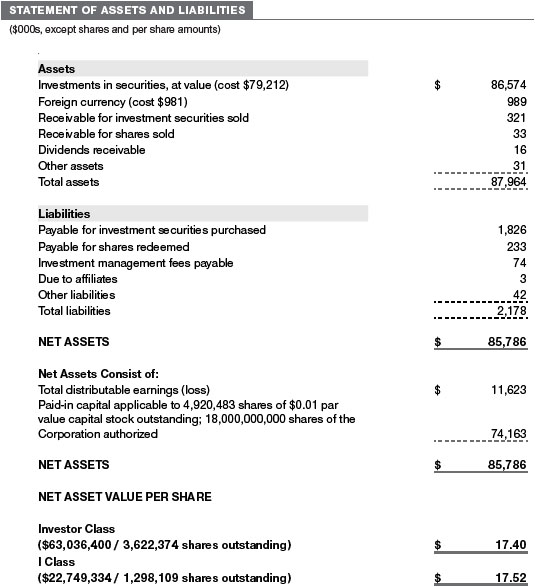
The accompanying notes are an integral part of these financial statements.
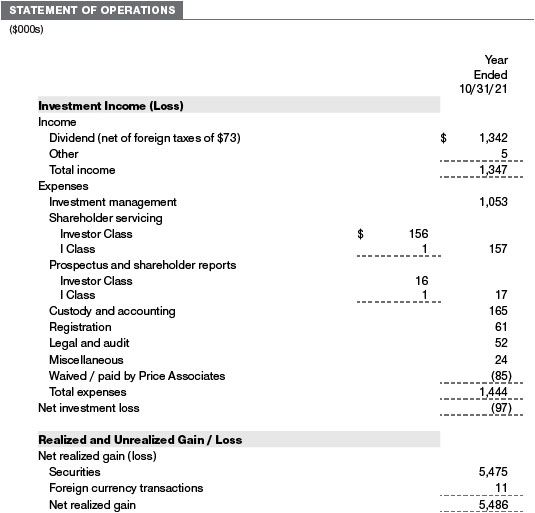

The accompanying notes are an integral part of these financial statements.
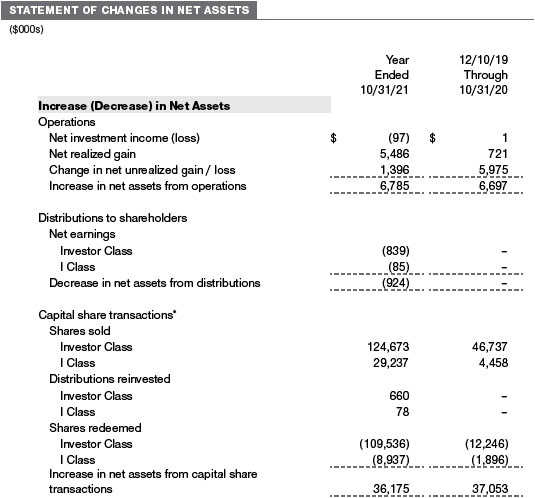
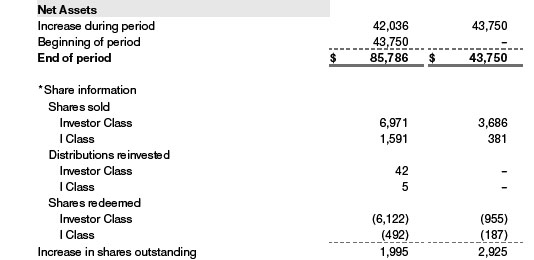
The accompanying notes are an integral part of these financial statements.
| NOTES TO FINANCIAL STATEMENTS |
T. Rowe Price International Funds, Inc. (the corporation) is registered under the Investment Company Act of 1940 (the 1940 Act). The China Evolution Equity Fund (the fund) is a nondiversified, open-end management investment company established by the corporation. The fund incepted on December 10, 2019. The fund seeks long-term growth of capital. The fund has two classes of shares: the China Evolution Equity Fund (Investor Class) and the China Evolution Equity Fund–I Class (I Class). I Class shares require a $1 million initial investment minimum, although the minimum generally is waived for retirement plans, financial intermediaries, and certain other accounts. Each class has exclusive voting rights on matters related solely to that class; separate voting rights on matters that relate to both classes; and, in all other respects, the same rights and obligations as the other class.
NOTE 1 - SIGNIFICANT ACCOUNTING POLICIES
Basis of Preparation The fund is an investment company and follows accounting and reporting guidance in the Financial Accounting Standards Board (FASB) Accounting Standards Codification Topic 946 (ASC 946). The accompanying financial statements were prepared in accordance with accounting principles generally accepted in the United States of America (GAAP), including, but not limited to, ASC 946. GAAP requires the use of estimates made by management. Management believes that estimates and valuations are appropriate; however, actual results may differ from those estimates, and the valuations reflected in the accompanying financial statements may differ from the value ultimately realized upon sale or maturity.
Investment Transactions, Investment Income, and Distributions Investment transactions are accounted for on the trade date basis. Income and expenses are recorded on the accrual basis. Realized gains and losses are reported on the identified cost basis. Income tax-related interest and penalties, if incurred, are recorded as income tax expense. Dividends received from mutual fund investments are reflected as dividend income; capital gain distributions are reflected as realized gain/loss. Dividend income and capital gain distributions are recorded on the ex-dividend date. Non-cash dividends, if any, are recorded at the fair market value of the asset received. Distributions to shareholders are recorded on the ex-dividend date. Income distributions, if any, are declared and paid by each class annually. A capital gain distribution may also be declared and paid by the fund annually.
Currency Translation Assets, including investments, and liabilities denominated in foreign currencies are translated into U.S. dollar values each day at the prevailing exchange rate, using the mean of the bid and asked prices of such currencies against U.S. dollars as provided by an outside pricing service. Purchases and sales of securities, income, and expenses are translated into U.S. dollars at the prevailing exchange rate on the respective date of such transaction. The effect of changes in foreign currency exchange rates on realized and unrealized security gains and losses is not bifurcated from the portion attributable to changes in market prices.
Class Accounting Shareholder servicing, prospectus, and shareholder report expenses incurred by each class are charged directly to the class to which they relate. Expenses common to all classes, investment income, and realized and unrealized gains and losses are allocated to the classes based upon the relative daily net assets of each class.
Capital Transactions Each investor’s interest in the net assets of the fund is represented by fund shares. The fund’s net asset value (NAV) per share is computed at the close of the New York Stock Exchange (NYSE), normally 4 p.m. ET, each day the NYSE is open for business. However, the NAV per share may be calculated at a time other than the normal close of the NYSE if trading on the NYSE is restricted, if the NYSE closes earlier, or as may be permitted by the SEC. Purchases and redemptions of fund shares are transacted at the next-computed NAV per share, after receipt of the transaction order by T. Rowe Price Associates, Inc., or its agents.
Indemnification In the normal course of business, the fund may provide indemnification in connection with its officers and directors, service providers, and/or private company investments. The fund’s maximum exposure under these arrangements is unknown; however, the risk of material loss is currently considered to be remote.
NOTE 2 - VALUATION
Fair Value The fund’s financial instruments are valued at the close of the NYSE and are reported at fair value, which GAAP defines as the price that would be received to sell an asset or paid to transfer a liability in an orderly transaction between market participants at the measurement date. The T. Rowe Price Valuation Committee (the Valuation Committee) is an internal committee that has been delegated certain responsibilities by the fund’s Board of Directors (the Board) to ensure that financial instruments are appropriately priced at fair value in accordance with GAAP and the 1940 Act. Subject to oversight by the Board, the Valuation Committee develops and oversees pricing-related policies and procedures and approves all fair value determinations. Specifically, the Valuation Committee establishes policies and procedures used in valuing financial instruments, including those which cannot be valued in accordance with normal procedures or using pricing vendors; determines pricing techniques, sources, and persons eligible to effect fair value pricing actions; evaluates the services and performance of the pricing vendors; oversees the pricing process to ensure policies and procedures are being followed; and provides guidance on internal controls and valuation-related matters. The Valuation Committee provides periodic reporting to the Board on valuation matters.
Various valuation techniques and inputs are used to determine the fair value of financial instruments. GAAP establishes the following fair value hierarchy that categorizes the inputs used to measure fair value:
Level 1 – quoted prices (unadjusted) in active markets for identical financial instruments that the fund can access at the reporting date
Level 2 – inputs other than Level 1 quoted prices that are observable, either directly or indirectly (including, but not limited to, quoted prices for similar financial instruments in active markets, quoted prices for identical or similar financial instruments in inactive markets, interest rates and yield curves, implied volatilities, and credit spreads)
Level 3 – unobservable inputs (including the fund’s own assumptions in determining fair value)
Observable inputs are developed using market data, such as publicly available information about actual events or transactions, and reflect the assumptions that market participants would use to price the financial instrument. Unobservable inputs are those for which market data are not available and are developed using the best information available about the assumptions that market participants would use to price the financial instrument. GAAP requires valuation techniques to maximize the use of relevant observable inputs and minimize the use of unobservable inputs. When multiple inputs are used to derive fair value, the financial instrument is assigned to the level within the fair value hierarchy based on the lowest-level input that is significant to the fair value of the financial instrument. Input levels are not necessarily an indication of the risk or liquidity associated with financial instruments at that level but rather the degree of judgment used in determining those values.
Valuation Techniques Equity securities, including exchange-traded funds, listed or regularly traded on a securities exchange or in the over-the-counter (OTC) market are valued at the last quoted sale price or, for certain markets, the official closing price at the time the valuations are made. OTC Bulletin Board securities are valued at the mean of the closing bid and asked prices. A security that is listed or traded on more than one exchange is valued at the quotation on the exchange determined to be the primary market for such security. Listed securities not traded on a particular day are valued at the mean of the closing bid and asked prices for domestic securities and the last quoted sale or closing price for international securities.
The last quoted prices of non-U.S. equity securities may be adjusted to reflect the fair value of such securities at the close of the NYSE, if the fund determines that developments between the close of a foreign market and the close of the NYSE will affect the value of some or all of its portfolio securities. Each business day, the fund uses information from outside pricing services to evaluate and, if appropriate, decide whether it is necessary to adjust quoted prices to reflect fair value by reviewing a variety of factors, including developments in foreign markets, the performance of U.S. securities markets, and the performance of instruments trading in U.S. markets that represent foreign securities and baskets of foreign securities. The fund uses outside pricing services to provide it with quoted prices and information to evaluate or adjust those prices. The fund cannot predict how often it will use quoted prices and how often it will determine it necessary to adjust those prices to reflect fair value.
Investments in mutual funds are valued at the mutual fund’s closing NAV per share on the day of valuation. Assets and liabilities other than financial instruments, including short-term receivables and payables, are carried at cost, or estimated realizable value, if less, which approximates fair value.
Investments for which market quotations or market-based valuations are not readily available or deemed unreliable are valued at fair value as determined in good faith by the Valuation Committee, in accordance with fair valuation policies and procedures. The objective of any fair value pricing determination is to arrive at a price that could reasonably be expected from a current sale. Financial instruments fair valued by the Valuation Committee are primarily private placements, restricted securities, warrants, rights, and other securities that are not publicly traded. Factors used in determining fair value vary by type of investment and may include market or investment specific considerations. The Valuation Committee typically will afford greatest weight to actual prices in arm’s length transactions, to the extent they represent orderly transactions between market participants, transaction information can be reliably obtained, and prices are deemed representative of fair value. However, the Valuation Committee may also consider other valuation methods such as market-based valuation multiples; a discount or premium from market value of a similar, freely traded security of the same issuer; discounted cash flows; yield to maturity; or some combination. Fair value determinations are reviewed on a regular basis and updated as information becomes available, including actual purchase and sale transactions of the investment. Because any fair value determination involves a significant amount of judgment, there is a degree of subjectivity inherent in such pricing decisions, and fair value prices determined by the Valuation Committee could differ from those of other market participants.
Valuation Inputs The following table summarizes the fund’s financial instruments, based on the inputs used to determine their fair values on October 31, 2021 (for further detail by category, please refer to the accompanying Portfolio of Investments):

NOTE 3 - OTHER INVESTMENT TRANSACTIONS
Consistent with its investment objective, the fund engages in the following practices to manage exposure to certain risks and/or to enhance performance. The investment objective, policies, program, and risk factors of the fund are described more fully in the fund’s prospectus and Statement of Additional Information.
Emerging and Frontier Markets The fund invests, either directly or through investments in other T. Rowe Price funds, in securities of companies located in, issued by governments of, or denominated in or linked to the currencies of emerging and frontier market countries. Emerging markets, and to a greater extent frontier markets, generally have economic structures that are less diverse and mature, and political systems that are less stable, than developed countries. These markets may be subject to greater political, economic, and social uncertainty and differing regulatory environments that may potentially impact the fund’s ability to buy or sell certain securities or repatriate proceeds to U.S. dollars. Such securities are often subject to greater price volatility, less liquidity, and higher rates of inflation than U.S. securities. Investing in frontier markets is significantly riskier than investing in other countries, including emerging markets.
China A Shares The fund invests in certain Chinese equity securities (A shares) that have limited availability to investors outside of China. The fund gains access to the A share market through the Shanghai-Hong Kong Stock Connect program (Shanghai Stock Connect), through the Shenzhen-Hong Kong Stock Connect program (Shenzhen Stock Connect), or through a wholly owned subsidiary of Price Associates, which serves as the registered Qualified Foreign Institutional Investor (QFII) for all participating T. Rowe Price-sponsored products (each a participating account). Related to A shares held through the QFII, investment decisions are specific to each participating account, and each account bears the economic consequences of its holdings and transactions in A shares. Further, the fund’s ability to repatriate cash associated with its A shares held through the QFII is subject to certain restrictions and administrative processes involving the Chinese government; consequently, the fund may experience substantial delays in gaining access to its assets or incur a loss of value in the event of noncompliance with governmental requirements. A shares acquired through the QFII are valued using the onshore renminbi exchange rate (CNY), and those acquired through the Shanghai Stock Connect and the Shenzhen Stock Connect are valued using the offshore renminbi exchange rate (CNH). CNY and CNH exchange rates may differ; accordingly, A shares of the same issue purchased through different channels may not have the same U.S. dollar value. Generally, the fund is not subject to capital gains tax related to its A share investments.
Other Purchases and sales of portfolio securities other than short-term securities aggregated $139,354,000 and $104,030,000, respectively, for the year ended October 31, 2021.
NOTE 4 - FEDERAL INCOME TAXES
Generally, no provision for federal income taxes is required since the fund intends to continue to qualify as a regulated investment company under Subchapter M of the Internal Revenue Code and distribute to shareholders all of its taxable income and gains. Distributions determined in accordance with federal income tax regulations may differ in amount or character from net investment income and realized gains for financial reporting purposes.
The fund files U.S. federal, state, and local tax returns as required. The fund’s tax returns are subject to examination by the relevant tax authorities until expiration of the applicable statute of limitations, which is generally three years after the filing of the tax return but which can be extended to six years in certain circumstances. Tax returns for open years have incorporated no uncertain tax positions that require a provision for income taxes.
Financial reporting records are adjusted for permanent book/tax differences to reflect tax character but are not adjusted for temporary differences. The permanent book/tax adjustments have no impact on results of operations or net assets and relate primarily to a tax practice that treats a portion of the proceeds from each redemption of capital shares as a distribution of taxable net investment income or realized capital gain and the offset of the current net operating loss against realized gains. For the year ended October 31, 2021, the following reclassification was recorded:

Distributions during the year ended October 31, 2021 were characterized for tax purposes as $924,000 of ordinary income. At October 31, 2021, the tax-basis cost of investments and components of net assets were as follows:
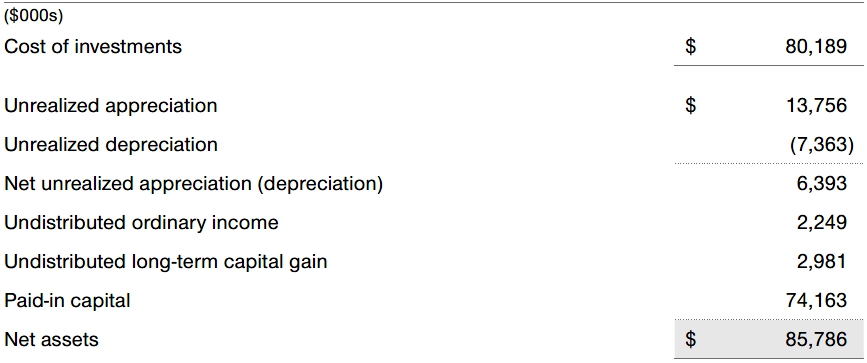
The difference between book-basis and tax-basis net unrealized appreciation (depreciation) is attributable to the deferral of losses from wash sales and the realization of gains/losses on passive foreign investment companies for tax purposes.
NOTE 5 - FOREIGN TAXES
The fund is subject to foreign income taxes imposed by certain countries in which it invests. Additionally, capital gains realized upon disposition of securities issued in or by certain foreign countries are subject to capital gains tax imposed by those countries. All taxes are computed in accordance with the applicable foreign tax law, and, to the extent permitted, capital losses are used to offset capital gains. Taxes attributable to income are accrued by the fund as a reduction of income. Current and deferred tax expense attributable to capital gains is reflected as a component of realized or change in unrealized gain/loss on securities in the accompanying financial statements. To the extent that the fund has country specific capital loss carryforwards, such carryforwards are applied against net unrealized gains when determining the deferred tax liability. Any deferred tax liability incurred by the fund is included in either Other liabilities or Deferred tax liability on the accompanying Statement of Assets and Liabilities.
NOTE 6 - RELATED PARTY TRANSACTIONS
The fund is managed by T. Rowe Price Associates, Inc. (Price Associates), a wholly owned subsidiary of T. Rowe Price Group, Inc. (Price Group). Price Associates has entered into a sub-advisory agreement(s) with one or more of its wholly owned subsidiaries, to provide investment advisory services to the fund. The investment management agreement between the fund and Price Associates provides for an annual investment management fee, which is computed daily and paid monthly. The fee consists of an individual fund fee, equal to 0.70% of the fund’s average daily net assets, and a group fee. The group fee rate is calculated based on the combined net assets of certain mutual funds sponsored by Price Associates (the group) applied to a graduated fee schedule, with rates ranging from 0.48% for the first $1 billion of assets to 0.260% for assets in excess of $845 billion. The fund’s group fee is determined by applying the group fee rate to the fund’s average daily net assets. The fee is computed daily and paid monthly. At October 31, 2021, the effective annual group fee rate was 0.28%.
The Investor Class is subject to a contractual expense limitation through the expense limitation date indicated in the table below. During the limitation period, Price Associates is required to waive its management fee or pay any expenses (excluding interest; expenses related to borrowings, taxes, and brokerage; and other non-recurring expenses permitted by the investment management agreement) that would otherwise cause the class’s ratio of annualized total expenses to average net assets (net expense ratio) to exceed its expense limitation. The class is required to repay Price Associates for expenses previously waived/paid to the extent the class’s net assets grow or expenses decline sufficiently to allow repayment without causing the class’s net expense ratio (after the repayment is taken into account) to exceed the lesser of: (1) the expense limitation in place at the time such amounts were waived; or (2) the class’s current expense limitation. However, no repayment will be made more than three years after the date of a payment or waiver.
The I Class is also subject to an operating expense limitation (I Class Limit) pursuant to which Price Associates is contractually required to pay all operating expenses of the I Class, excluding management fees; interest; expenses related to borrowings, taxes, and brokerage; and other non-recurring expenses permitted by the investment management agreement, to the extent such operating expenses, on an annualized basis, exceed the I Class Limit. This agreement will continue through the expense limitation date indicated in the table below, and may be renewed, revised, or revoked only with approval of the fund’s Board. The I Class is required to repay Price Associates for expenses previously paid to the extent the class’s net assets grow or expenses decline sufficiently to allow repayment without causing the class’s operating expenses (after the repayment is taken into account) to exceed the lesser of: (1) the I Class Limit in place at the time such amounts were paid; or (2) the current I Class Limit. However, no repayment will be made more than three years after the date of a payment or waiver.
Pursuant to these agreements, expenses were waived/paid by and/or repaid to Price Associates during the year ended October 31, 2021 as indicated in the table below. Including this amount, expenses previously waived/paid by Price Associates in the amount of $284,000 remain subject to repayment by the fund at October 31, 2021. Any repayment of expenses previously waived/paid by Price Associates during the period would be included in the net investment income and expense ratios presented on the accompanying Financial Highlights.

In addition, the fund has entered into service agreements with Price Associates and a wholly owned subsidiary of Price Associates, each an affiliate of the fund (collectively, Price). Price Associates provides certain accounting and administrative services to the fund. T. Rowe Price Services, Inc. provides shareholder and administrative services in its capacity as the fund’s transfer and dividend-disbursing agent. For the year ended October 31, 2021, expenses incurred pursuant to these service agreements were $73,000 for Price Associates and $125,000 for T. Rowe Price Services, Inc. All amounts due to and due from Price, exclusive of investment management fees payable, are presented net on the accompanying Statement of Assets and Liabilities.
The fund may invest its cash reserves in certain open-end management investment companies managed by Price Associates and considered affiliates of the fund: the T. Rowe Price Government Reserve Fund or the T. Rowe Price Treasury Reserve Fund, organized as money market funds, or the T. Rowe Price Short-Term Fund, a short-term bond fund (collectively, the Price Reserve Funds). The Price Reserve Funds are offered as short-term investment options to mutual funds, trusts, and other accounts managed by Price Associates or its affiliates and are not available for direct purchase by members of the public. Cash collateral from securities lending, if any, is invested in the T. Rowe Price Short-Term Fund. The Price Reserve Funds pay no investment management fees.
The fund may participate in securities purchase and sale transactions with other funds or accounts advised by Price Associates (cross trades), in accordance with procedures adopted by the fund’s Board and Securities and Exchange Commission rules, which require, among other things, that such purchase and sale cross trades be effected at the independent current market price of the security. During the year ended October 31, 2021, the fund had no purchases or sales cross trades with other funds or accounts advised by Price Associates.
NOTE 7 - OTHER MATTERS
Unpredictable events such as environmental or natural disasters, war, terrorism, pandemics, outbreaks of infectious diseases, and similar public health threats may significantly affect the economy and the markets and issuers in which a fund invests. Certain events may cause instability across global markets, including reduced liquidity and disruptions in trading markets, while some events may affect certain geographic regions, countries, sectors, and industries more significantly than others, and exacerbate other pre-existing political, social, and economic risks. The fund’s performance could be negatively impacted if the value of a portfolio holding were harmed by such events. Since 2020, a novel strain of coronavirus (COVID-19) has resulted in disruptions to global business activity and caused significant volatility and declines in global financial markets. The duration of this outbreak or others and their effects cannot be determined with certainty.
REPORT OF INDEPENDENT REGISTERED PUBLIC ACCOUNTING FIRM
To the Board of Directors of T. Rowe Price International Funds, Inc. and
Shareholders of T. Rowe Price China Evolution Equity Fund
Opinion on the Financial Statements
We have audited the accompanying statement of assets and liabilities, including the portfolio of investments, of T. Rowe Price China Evolution Equity Fund (one of the funds constituting T. Rowe Price International Funds, Inc., referred to hereafter as the “Fund”) as of October 31, 2021, and the related statements of operations for the year ended October 31, 2021, and the statement of changes in net assets and the financial highlights for the year ended October 31, 2021 and for the period December 10, 2019 (Inception) through October 31, 2020 (collectively referred to as the “financial statements”). In our opinion, the financial statements present fairly, in all material respects, the financial position of the Fund as of October 31, 2021, the results of its operations for the year then ended, and the changes in its net assets and the financial highlights for the year ended October 31, 2021 and for the period December 10, 2019 (Inception) through October 31, 2020 in conformity with accounting principles generally accepted in the United States of America.
Basis for Opinion
These financial statements are the responsibility of the Fund’s management. Our responsibility is to express an opinion on the Fund’s financial statements based on our audit. We are a public accounting firm registered with the Public Company Accounting Oversight Board (United States) (PCAOB) and are required to be independent with respect to the Fund in accordance with the U.S. federal securities laws and the applicable rules and regulations of the Securities and Exchange Commission and the PCAOB.
We conducted our audit of these financial statements in accordance with the standards of the PCAOB. Those standards require that we plan and perform the audit to obtain reasonable assurance about whether the financial statements are free of material misstatement, whether due to error or fraud.
Our audit included performing procedures to assess the risks of material misstatement of the financial statements, whether due to error or fraud, and performing procedures that respond to those risks. Such procedures included examining, on a test basis, evidence regarding the amounts and disclosures in the financial statements. Our audit also included evaluating the accounting principles used and significant estimates made by management, as well as evaluating the overall presentation of the financial statements. Our procedures included confirmation of securities owned as of October 31, 2021 by correspondence with the custodian, transfer agent and brokers; when replies were not received from brokers, we performed other auditing procedures. We believe that our audit provides a reasonable basis for our opinion.
PricewaterhouseCoopers LLP
Baltimore, Maryland
December 17, 2021
We have served as the auditor of one or more investment companies in the T. Rowe Price group of investment companies since 1973.
TAX INFORMATION (UNAUDITED) FOR THE TAX YEAR ENDED 10/31/21
We are providing this information as required by the Internal Revenue Code. The amounts shown may differ from those elsewhere in this report because of differences between tax and financial reporting requirements.
The fund’s distributions to shareholders included:
| ■ | $1,129,000 from short-term capital gains |
| ■ | $653,000 from long-term capital gains, subject to a long-term capital gains tax rate of not greater than 20% |
For taxable non-corporate shareholders, $606,000 of the fund's income represents qualified dividend income subject to a long-term capital gains tax rate of not greater than 20%.
The fund will pass through foreign source income of $1,285,000 and foreign taxes paid of $73,000.
INFORMATION ON PROXY VOTING POLICIES, PROCEDURES, AND RECORDS
A description of the policies and procedures used by T. Rowe Price funds to determine how to vote proxies relating to portfolio securities is available in each fund’s Statement of Additional Information. You may request this document by calling 1-800-225-5132 or by accessing the SEC’s website, sec.gov.
The description of our proxy voting policies and procedures is also available on our corporate website. To access it, please visit the following Web page:
https://www.troweprice.com/corporate/en/utility/policies.html
Scroll down to the section near the bottom of the page that says, “Proxy Voting Policies.” Click on the Proxy Voting Policies link in the shaded box.
Each fund’s most recent annual proxy voting record is available on our website and through the SEC’s website. To access it through T. Rowe Price, visit the website location shown above, and scroll down to the section near the bottom of the page that says, “Proxy Voting Records.” Click on the Proxy Voting Records link in the shaded box.
HOW TO OBTAIN QUARTERLY PORTFOLIO HOLDINGS
The fund files a complete schedule of portfolio holdings with the Securities and Exchange Commission (SEC) for the first and third quarters of each fiscal year as an exhibit to its reports on Form N-PORT. The fund’s reports on Form N-PORT are available electronically on the SEC’s website (sec.gov). In addition, most T. Rowe Price funds disclose their first and third fiscal quarter-end holdings on troweprice.com.
LIQUIDITY RISK MANAGEMENT PROGRAM
In accordance with Rule 22e-4 (Liquidity Rule) under the Investment Company Act of 1940, as amended, the fund has established a liquidity risk management program (Liquidity Program) reasonably designed to assess and manage the fund’s liquidity risk, which generally represents the risk that the fund would not be able to meet redemption requests without significant dilution of remaining investors’ interests in the fund. The fund’s Board of Directors (Board) has appointed the fund’s investment advisor, T. Rowe Price Associates, Inc. (Price Associates), as the administrator of the Liquidity Program. As administrator, Price Associates is responsible for overseeing the day-to-day operations of the Liquidity Program and, among other things, is responsible for assessing, managing, and reviewing with the Board at least annually the liquidity risk of each T. Rowe Price fund. Price Associates has delegated oversight of the Liquidity Program to a Liquidity Risk Committee (LRC), which is a cross-functional committee composed of personnel from multiple departments within Price Associates.
The Liquidity Program’s principal objectives include supporting the T. Rowe Price funds’ compliance with limits on investments in illiquid assets and mitigating the risk that the fund will be unable to timely meet its redemption obligations. The Liquidity Program also includes a number of elements that support the management and assessment of liquidity risk, including an annual assessment of factors that influence the fund’s liquidity and the periodic classification and reclassification of a fund’s investments into categories that reflect the LRC’s assessment of their relative liquidity under current market conditions. Under the Liquidity Program, every investment held by the fund is classified at least monthly into one of four liquidity categories based on estimations of the investment’s ability to be sold during designated time frames in current market conditions without significantly changing the investment’s market value.
As required by the Liquidity Rule, at a meeting held on July 27, 2021, the Board was presented with an annual assessment prepared by the LRC, on behalf of Price Associates, that addressed the operation of the Liquidity Program and assessed its adequacy and effectiveness of implementation, including any material changes to the Liquidity Program and the determination of each fund’s Highly Liquid Investment Minimum (HLIM). The annual assessment included consideration of the following factors, as applicable: the fund’s investment strategy and liquidity of portfolio investments during normal and reasonably foreseeable stressed conditions, including whether the investment strategy is appropriate for an open-end fund, the extent to which the strategy involves a relatively concentrated portfolio or large positions in particular issuers, and the use of borrowings for investment purposes and derivatives; short-term and long-term cash flow projections covering both normal and reasonably foreseeable stressed conditions; and holdings of cash and cash equivalents, as well as available borrowing arrangements.
For the fund and other T. Rowe Price funds, the annual assessment incorporated a report related to a fund’s holdings, shareholder and portfolio concentration, any borrowings during the period, cash flow projections, and other relevant data for the period of April 1, 2020, through March 31, 2021. The report described the methodology for classifying a fund’s investments (including derivative transactions) into one of four liquidity categories, as well as the percentage of a fund’s investments assigned to each category. It also explained the methodology for establishing a fund’s HLIM and noted that the LRC reviews the HLIM assigned to each fund no less frequently than annually.
During the period covered by the annual assessment, the LRC has concluded, and reported to the Board, that the Liquidity Program continues to operate adequately and effectively and is reasonably designed to assess and manage the fund’s liquidity risk.
ABOUT THE FUND’S DIRECTORS AND OFFICERS
Your fund is overseen by a Board of Directors (Board) that meets regularly to review a wide variety of matters affecting or potentially affecting the fund, including performance, investment programs, compliance matters, advisory fees and expenses, service providers, and business and regulatory affairs. The Board elects the fund’s officers, who are listed in the final table. At least 75% of the Board’s members are considered to be independent, i.e., not “interested persons” as defined in Section 2(a)(19) of the 1940 Act, of the Boards of T. Rowe Price Associates, Inc. (T. Rowe Price), and its affiliates; “interested” directors and officers are employees of T. Rowe Price. The business address of each director and officer is 100 East Pratt Street, Baltimore, Maryland 21202. The Statement of Additional Information includes additional information about the fund directors and is available without charge by calling a T. Rowe Price representative at 1-800-638-5660.
| INDEPENDENT DIRECTORS(a) | ||
| Name (Year of Birth) Year Elected [Number of T. Rowe Price Portfolios Overseen] | Principal Occupation(s) and Directorships of Public Companies and Other Investment Companies During the Past Five Years | |
| Teresa Bryce Bazemore (1959) 2018 [204] | President and Chief Executive Officer, Federal Home Loan Bank of San Francisco (2021 to present); President, Radian Guaranty (2008 to 2017); Chief Executive Officer, Bazemore Consulting LLC (2018 to 2021); Director, Chimera Investment Corporation (2017 to 2021); Director, First Industrial Realty Trust (2020 to present); Director, Federal Home Loan Bank of Pittsburgh (2017 to 2019) | |
| Ronald J. Daniels (1959) 2018 [204] | President, The Johns Hopkins University(b) and Professor, Political Science Department, The Johns Hopkins University (2009 to present); Director, Lyndhurst Holdings (2015 to present); Director, BridgeBio Pharma, Inc. (2020 to present) | |
| Bruce W. Duncan (1951) 2013 [204] | President, Chief Executive Officer, and Director, CyrusOne, Inc. (2020 to 2021); Chief Executive Officer and Director (2009 to 2016), Chair of the Board (2016 to 2020), and President (2009 to 2016), First Industrial Realty Trust, owner and operator of industrial properties; Chair of the Board (2005 to 2016) and Director (1999 to 2016), Starwood Hotels & Resorts, a hotel and leisure company; Member, Investment Company Institute Board of Governors (2017 to 2019); Member, Independent Directors Council Governing Board (2017 to 2019); Senior Advisor, KKR (2018 to present); Director, Boston Properties (2016 to present); Director, Marriott International, Inc. (2016 to 2020) | |
| Robert J. Gerrard, Jr. (1952) 2012 [204] | Advisory Board Member, Pipeline Crisis/Winning Strategies, a collaborative working to improve opportunities for young African Americans (1997 to 2016); Chair of the Board, all funds (July 2018 to present) | |
| Paul F. McBride (1956) 2013 [204] | Advisory Board Member, Vizzia Technologies (2015 to present); Board Member, Dunbar Armored (2012 to 2018) | |
| Cecilia E. Rouse, Ph.D.(c) (1963) 2013 [0] | Dean, Princeton School of Public and International Affairs (2012 to present); Professor and Researcher, Princeton University (1992 to present); Director of Education Studies Committee, MDRC, a nonprofit education and social policy research organization (2011 to 2020); Member, National Academy of Education (2010 to present); Board Member, National Bureau of Economic Research (2011 to present); Board Member of the Council on Foreign Relations (2018 to present); Board Member, The Pennington School (2017 to present); Board Member, the University of Rhode Island (2020 to present); Chair of Committee on the Status of Minority Groups in the Economic Profession of the American Economic Association (2012 to 2018); Vice President (2015 to 2016) and Board Member (2018 to present), American Economic Association | |
| John G. Schreiber (1946) 2001 [204] | Owner/President, Centaur Capital Partners, Inc., a real estate investment company (1991 to present); Cofounder, Partner, and Cochair of the Investment Committee, Blackstone Real Estate Advisors, L.P. (1992 to 2015); Director, Blackstone Mortgage Trust, a real estate finance company (2012 to 2016); Director and Chair of the Board, Brixmor Property Group, Inc. (2013 to present); Director, Hilton Worldwide (2007 to present); Director, Hudson Pacific Properties (2014 to 2016); Director, Invitation Homes (2014 to 2017); Director, JMB Realty Corporation (1980 to present) | |
| (a)All information about the independent directors was current as of December 31, 2020, unless otherwise indicated, except for the number of portfolios overseen, which is current as of the date of this report. | ||
| (b)William J. Stromberg, chair of the Board, director, and chief executive officer of T. Rowe Price Group, Inc., the parent company of the Price Funds’ investment advisor, has served on the Board of Trustees of Johns Hopkins University since 2014. | ||
| (c)Effective March 4, 2021, Dr. Rouse resigned from her role as independent director of the Price Funds. | ||
INTERESTED DIRECTORS(a) | ||
| Name (Year of Birth) Year Elected [Number of T. Rowe Price Portfolios Overseen] | Principal Occupation(s) and Directorships of Public Companies and Other Investment Companies During the Past Five Years | |
| David Oestreicher (1967) 2018 [204] | General Counsel, Vice President, and Secretary, T. Rowe Price Group, Inc.; Chair of the Board, Chief Executive Officer, President, and Secretary, T. Rowe Price Trust Company; Director, Vice President, and Secretary, T. Rowe Price, T. Rowe Price Investment Services, Inc., T. Rowe Price Retirement Plan Services, Inc., and T. Rowe Price Services, Inc.; Director and Secretary, T. Rowe Price Investment Management, Inc.; Vice President and Secretary, T. Rowe Price International (Price International); Vice President, T. Rowe Price Hong Kong (Price Hong Kong), T. Rowe Price Japan (Price Japan), and T. Rowe Price Singapore (Price Singapore); Principal Executive Officer and Executive Vice President, all funds | |
| Robert W. Sharps, CFA, CPA (1971) 2017 [204] | Director and Vice President, T. Rowe Price; President, T. Rowe Price Group, Inc.; Director, T. Rowe Price Investment Management, Inc.; Vice President, T. Rowe Price Trust Company; Vice President, International Funds | |
| (a)All information about the interested directors was current as of December 31, 2020, unless otherwise indicated, except for the number of portfolios overseen, which is current as of the date of this report. | ||
| OFFICERS | ||
| Name (Year of Birth) Position Held With International Funds | Principal Occupation(s) | |
| Mariel Abreu (1981) Vice President | Vice President, T. Rowe Price and T. Rowe Price Group, Inc. | |
| Jason R. Adams (1979) Executive Vice President | Vice President T. Rowe Price and T. Rowe Price Group, Inc. | |
| Ulle Adamson, CFA (1979) Executive Vice President | Vice President, T. Rowe Price Group, Inc., and Price International | |
| Roy H. Adkins (1970) Vice President | Vice President, T. Rowe Price Group, Inc., and Price International | |
| Syed H. Ali (1970) Vice President | Vice President, Price Hong Kong, Price Singapore, and T. Rowe Price Group, Inc. | |
| Kennard W. Allen (1977) Vice President | Vice President, T. Rowe Price and T. Rowe Price Group, Inc. | |
| Paulina Amieva (1981) Vice President | Vice President, T. Rowe Price and T. Rowe Price Group, Inc. | |
| Malik S. Asif (1981) Executive Vice President | Vice President, T. Rowe Price Group, Inc., and Price International | |
| Ziad Bakri, M.D., CFA (1980) Vice President | Vice President, T. Rowe Price and T. Rowe Price Group, Inc. | |
| Harishankar Balkrishna (1983) Executive Vice President | Vice President, T. Rowe Price Group, Inc., and Price International | |
| Sheena L. Barbosa (1983) Vice President | Vice President, Price Hong Kong and T. Rowe Price Group, Inc. | |
| Peter J. Bates, CFA (1974) Executive Vice President | Vice President, T. Rowe Price and T. Rowe Price Group, Inc. | |
| Jason A. Bauer (1979) Vice President | Vice President, T. Rowe Price and T. Rowe Price Group, Inc. | |
| Luis M. Baylac (1982) Vice President | Vice President, T. Rowe Price Group, Inc., and Price International | |
| R. Scott Berg, CFA (1972) Executive Vice President | Vice President, T. Rowe Price, T. Rowe Price Group, Inc., and T. Rowe Price Trust Company | |
| Steven E. Boothe, CFA (1977) Vice President | Vice President, T. Rowe Price and T. Rowe Price Group, Inc. | |
| Peter I. Botoucharov (1965) Vice President | Vice President, T. Rowe Price Group, Inc., and Price International | |
| Tala Boulos (1984) Vice President | Vice President, T. Rowe Price Group, Inc., and Price International | |
| Christopher P. Brown, Jr., CFA (1977) Vice President | Vice President, T. Rowe Price and T. Rowe Price Group, Inc. | |
| Andrew Chang (1983) Vice President | Vice President, Price Singapore and T. Rowe Price Group, Inc. | |
| Carolyn Hoi Che Chu (1974) Vice President | Vice President, Price Hong Kong and T. Rowe Price Group, Inc. | |
| Vincent Chung (1988) Vice President | Vice President, T. Rowe Price Group, Inc., and Price International; formerly, Investment Analyst/Trader, Observatory Capital Management LLP (to 2019) | |
| Archibald Ciganer, CFA (1976) Executive Vice President | Director and Vice President, Price Japan; Vice President, T. Rowe Price Group, Inc. | |
| Richard N. Clattenburg, CFA (1979) Executive Vice President | Vice President, Price Singapore, T. Rowe Price, T. Rowe Price Group, Inc., Price International, and T. Rowe Price Trust Company | |
| Michael J. Conelius, CFA (1964) Vice President | Vice President, T. Rowe Price, T. Rowe Price Group, Inc., Price International, and T. Rowe Price Trust Company | |
| Michael F. Connelly, CFA (1977) Vice President | Vice President, T. Rowe Price and T. Rowe Price Group, Inc. | |
| Andrew S. Davis (1978) Vice President | Vice President, T. Rowe Price and T. Rowe Price Group, Inc. | |
| Richard de los Reyes (1975) Vice President | Vice President, T. Rowe Price, T. Rowe Price Group, Inc., and T. Rowe Price Trust Company | |
| Michael Della Vedova (1969) Executive Vice President | Vice President, T. Rowe Price Group, Inc., and T. Rowe Price International | |
| Iona Dent, CFA (1991) Vice President | Vice President, Price International; formerly, Associate, Equity Research, Deutsche Bank (to 2018) | |
| Maria Elena Drew (1973) Vice President | Vice President, T. Rowe Price Group, Inc., and Price International; formerly, Executive Director, Goldman Sachs Asset Management (to 2017) | |
| Shawn T. Driscoll (1975) Vice President | Vice President, T. Rowe Price, T. Rowe Price Group, Inc., and T. Rowe Price Trust Company | |
| Alan S. Dupski, CPA (1982) Principal Financial Officer, Vice President, and Treasurer | Vice President, T. Rowe Price, T. Rowe Price Group, Inc., and T. Rowe Price Trust Company | |
| Bridget A. Ebner (1970) Vice President | Vice President, T. Rowe Price and T. Rowe Price Group, Inc. | |
| David J. Eiswert, CFA (1972) Executive Vice President | Vice President, T. Rowe Price and T. Rowe Price Group, Inc. | |
| Dawei Feng (1979) Vice President | Vice President, Price Hong Kong and T. Rowe Price Group, Inc.; formerly, Head of China Consumer in Equity Research, Credit Lyonnais Asia-Pacific (to 2018) | |
| Ryan W. Ferro (1985) Vice President | Vice President, T. Rowe Price and T. Rowe Price Group, Inc. | |
| Mark S. Finn, CFA, CPA (1963) Vice President | Vice President, T. Rowe Price, T. Rowe Price Group, Inc., and T. Rowe Price Trust Company | |
| Quentin S. Fitzsimmons (1968) Vice President | Vice President, T. Rowe Price Group, Inc., and Price International | |
| Melissa C. Gallagher (1974) Vice President | Vice President, T. Rowe Price Group, Inc., and Price International | |
| Justin T. Gerbereux, CFA (1975) Vice President | Vice President, T. Rowe Price, T. Rowe Price Group, Inc., and T. Rowe Price Trust Company | |
| Aaron Gifford, CFA (1987) Vice President | Vice President, T. Rowe Price and T. Rowe Price Group, Inc.; formerly, Strategist, Morgan Stanley & Co. LLC (to 2017) | |
| John R. Gilner (1961) Chief Compliance Officer | Chief Compliance Officer and Vice President, T. Rowe Price; Vice President, T. Rowe Price Group, Inc., and T. Rowe Price Investment Services, Inc. | |
| Vishnu V. Gopal (1979) Vice President | Vice President, Price Hong Kong and T. Rowe Price Group, Inc. | |
| Joel Grant (1978) Vice President | Vice President, T. Rowe Price and T. Rowe Price Group, Inc. | |
| Gary J. Greb (1961) Vice President | Vice President, T. Rowe Price, Price International, and T. Rowe Price Trust Company | |
| Paul D. Greene II (1978) Vice President | Vice President, T. Rowe Price and T. Rowe Price Group, Inc. | |
| Benjamin Griffiths, CFA (1977) Executive Vice President | Vice President, T. Rowe Price Group, Inc., and Price International | |
| Gianluca Guicciardi (1983) Vice President | Vice President, T. Rowe Price Group, Inc., and T. Rowe Price International | |
| Shaoyu Guo (1992) Vice President | Vice President, Price Hong Kong; formerly, Economist, J.P. Morgan (to 2020); Research Analyst, International Monetary Fund (to 2017) | |
| Richard L. Hall (1979) Vice President | Vice President, T. Rowe Price and T. Rowe Price Group, Inc. | |
| Nabil Hanano, CFA (1984) Vice President | Vice President, T. Rowe Price Group, Inc., and Price International | |
| Jeffrey Holford, Ph.D., ACA (1972) Vice President | Vice President, T. Rowe Price and T. Rowe Price Group, Inc.; formerly, Managing Director, Jeffries Financial Group (to 2018) | |
| Stefan Hubrich, Ph.D., CFA (1974) Vice President | Vice President, T. Rowe Price and T. Rowe Price Group, Inc. | |
| Arif Husain, CFA (1972) Executive Vice President | Vice President, T. Rowe Price Group, Inc., and Price International | |
| Tetsuji Inoue (1971) Vice President | Vice President, Price Hong Kong, T. Rowe Price Group, Inc., and Price International | |
| Michael D. Jacobs (1971) Vice President | Vice President, Price Japan, T. Rowe Price Group, Inc., and Price International | |
| Randal S. Jenneke (1971) Vice President | Vice President, T. Rowe Price Group, Inc. | |
| Prashant G. Jeyaganesh (1983) Vice President | Vice President, T. Rowe Price and T. Rowe Price Group, Inc. | |
| Nina P. Jones, CPA (1980) Vice President | Vice President, T. Rowe Price and T. Rowe Price Group, Inc. | |
| Yoichiro Kai (1973) Vice President | Vice President, Price Singapore, T. Rowe Price Group, Inc., and Price International | |
| Jacob H. Kann, CFA (1987) Vice President | Vice President, T. Rowe Price and T. Rowe Price Group, Inc. | |
| Jai Kapadia (1982) Vice President | Vice President, Price Hong Kong and T. Rowe Price Group, Inc. | |
| Andrew J. Keirle (1974) Executive Vice President | Vice President, T. Rowe Price Group, Inc., and Price International | |
| Takanori Kobayashi (1981) Vice President | Vice President, Price Japan, T. Rowe Price Group, Inc., and Price International; formerly, Research Analyst, Allianz Global Investors (to 2017) | |
| Paul J. Krug, CPA (1964) Vice President | Vice President, T. Rowe Price, T. Rowe Price Group, Inc., and T. Rowe Price Trust Company | |
| Christopher J. Kushlis, CFA (1976) Vice President | Vice President, T. Rowe Price Group, Inc., and T. Rowe Price International | |
| Shengrong Lau (1982) Vice President | Vice President, Price Singapore and T. Rowe Price Group, Inc. | |
| Lu Liu (1979) Vice President | Vice President, Price Hong Kong and T. Rowe Price Group, Inc. | |
| Johannes Loefstrand (1988) Vice President | Vice President, T. Rowe Price Group, Inc., and Price International | |
| Anh Lu (1968) Executive Vice President | Vice President, Price Hong Kong and T. Rowe Price Group, Inc. | |
| Sebastien Mallet (1974) Vice President | Vice President, T. Rowe Price Group, Inc., and Price International | |
| Jennifer Martin (1972) Vice President | Vice President, T. Rowe Price and T. Rowe Price Group, Inc. | |
| Ryan Martyn (1979) Vice President | Vice President, T. Rowe Price Group, Inc., and Price International | |
| Colin McQueen (1967) Executive Vice President | Vice President, T. Rowe Price Group, Inc., and Price International; formerly, Senior Investment Manager, Global Equities, Sanlam FOUR Investments UK Limited (to 2019) | |
| Raymond A. Mills, Ph.D., CFA (1960) Executive Vice President | Vice President, T. Rowe Price, T. Rowe Price Group, Inc., Price International, and T. Rowe Price Trust Company | |
| Jihong Min (1979) Vice President | Vice President, Price Singapore and T. Rowe Price Group, Inc. | |
| Eric C. Moffett (1974) Executive Vice President | Vice President, Price Singapore and T. Rowe Price Group, Inc. | |
| Ivan Morozov, CFA (1987) Vice President | Vice President, T. Rowe Price Group, Inc., and Price International | |
| Samy B. Muaddi, CFA (1984) Executive Vice President | Vice President, T. Rowe Price, T. Rowe Price Group, Inc., and T. Rowe Price Trust Company | |
| Tobias F. Mueller, CFA (1980) Executive Vice President | Vice President, T. Rowe Price Group, Inc., and Price International | |
| Razan Nasser (1985) Vice President | Vice President, T. Rowe Price Group, Inc., and Price International; formerly, Senior Economist, HSBC Bank Middle East Ltd (to 2019) | |
| Joshua Nelson (1977) Executive Vice President | Vice President, T. Rowe Price, T. Rowe Price Group, Inc., Price International, and T. Rowe Price Trust Company | |
| Philip A. Nestico (1976) Vice President | Vice President, T. Rowe Price and T. Rowe Price Group, Inc. | |
| Sridhar Nishtala (1975) Vice President | Director and Vice President, Price Singapore; Vice President, T. Rowe Price Group, Inc. | |
| Jason Nogueira, CFA (1974) Executive Vice President | Vice President, T. Rowe Price and T. Rowe Price Group, Inc. | |
| Kenneth A. Orchard (1975) Executive Vice President | Vice President, T. Rowe Price Group, Inc., and Price International | |
| Oluwaseun Oyegunle, CFA (1984) Executive Vice President | Vice President, T. Rowe Price Group, Inc., and Price International | |
| Gonzalo Pángaro, CFA (1968) Executive Vice President | Vice President, T. Rowe Price Group, Inc., and Price International | |
| Fran M. Pollack-Matz (1961) Vice President and Secretary | Vice President, T. Rowe Price, T. Rowe Price Group, Inc., T. Rowe Price Investment Services, Inc., and T. Rowe Price Services, Inc. | |
| Shannon H. Rauser (1987) Assistant Secretary | Assistant Vice President, T. Rowe Price | |
| Todd Reese (1990) Vice President | Vice President, T. Rowe Price | |
| Melanie A. Rizzo (1982) Vice President | Vice President, T. Rowe Price and T. Rowe Price Group, Inc. | |
| David L. Rowlett, CFA (1975) Vice President | Vice President, T. Rowe Price and T. Rowe Price Group, Inc. | |
| Federico Santilli, CFA (1974) Executive Vice President | Vice President, T. Rowe Price Group, Inc., and Price International | |
| Nikolaj Schmidt (1975) Vice President | Vice President, T. Rowe Price Group, Inc., and T. Rowe Price International | |
| Sebastian Schrott (1977) Vice President | Vice President, T. Rowe Price Group, Inc., and Price International | |
| Bin Shen, CFA (1987) Vice President | Vice President, T. Rowe Price Group, Inc., and T. Rowe Price International | |
| John C.A. Sherman (1969) Vice President | Vice President, T. Rowe Price and T. Rowe Price Group, Inc. | |
| Gabriel Solomon (1977) Vice President | Vice President, T. Rowe Price and T. Rowe Price Group, Inc. | |
| Scott D. Solomon, CFA (1981) Vice President | Vice President, T. Rowe Price and T. Rowe Price Group, Inc. | |
| Joshua K. Spencer, CFA (1973) Vice President | Vice President, T. Rowe Price, T. Rowe Price Group, Inc., and T. Rowe Price Trust Company | |
| David Stanley (1963) Vice President | Vice President, T. Rowe Price Group, Inc., and Price International | |
| Saurabh Sud, CFA (1985) Executive Vice President | Vice President, T. Rowe Price and T. Rowe Price Group, Inc.; formerly, Senior Vice President, PIMCO (to 2018) | |
| Taymour R. Tamaddon, CFA (1976) Vice President | Vice President, T. Rowe Price, T. Rowe Price Group, Inc., and T. Rowe Price Trust Company | |
| Ju Yen Tan (1972) Vice President | Vice President, T. Rowe Price Group, Inc., and Price International | |
| Sin Dee Tan, CFA (1979) Vice President | Vice President, T. Rowe Price Group, Inc., and Price International | |
| Siby Thomas (1979) Executive Vice President | Vice President, T. Rowe Price and T. Rowe Price Group, Inc. | |
| Justin Thomson (1968) President | Director, Price Hong Kong; Vice President, T. Rowe Price Group, Inc.; Director and Vice President, Price International | |
| Mark J. Vaselkiv (1958) Executive Vice President | Vice President, T. Rowe Price, T. Rowe Price Group, Inc., and T. Rowe Price Trust Company | |
| Rupinder Vig (1979) Vice President | Vice President, T. Rowe Price Group, Inc., and Price International | |
| Willem Visser (1979) Vice President | Vice President, T. Rowe Price Group, Inc., and T. Rowe Price International; formerly, Investment Analyst, NN Investment Partners (to 2017) | |
| Chris Vost (1989) Vice President | Vice President, T. Rowe Price Group, Inc., and Price International | |
| Zenon Voyiatzis (1971) Vice President | Vice President, T. Rowe Price Group, Inc., and Price International | |
| Verena E. Wachnitz, CFA (1978) Executive Vice President | Vice President, T. Rowe Price Group, Inc., and Price International | |
| David J. Wallack (1960) Vice President | Vice President, T. Rowe Price, T. Rowe Price Group, Inc., and T. Rowe Price Trust Company | |
| Dai Wang (1989) Vice President | Vice President, Price Hong Kong and T. Rowe Price Group, Inc. | |
| Megan Warren (1968) Vice President | Vice President, T. Rowe Price, T. Rowe Price Group, Inc., T. Rowe Price Retirement Plan Services, Inc., T. Rowe Price Services, Inc., and T. Rowe Price Trust Company; formerly, Executive Director, JPMorgan Chase (to 2017) | |
| Hiroshi Watanabe, CFA (1975) Vice President | Director and Vice President, Price Japan; Vice President, T. Rowe Price Group, Inc. | |
| J. Howard Woodward, CFA (1974) Vice President | Vice President, T. Rowe Price Group, Inc., and Price International | |
| Marta Yago (1977) Vice President | Vice President, T. Rowe Price Group, Inc., and Price International | |
| Benjamin T. Yeagle (1978) Vice President | Vice President, T. Rowe Price and T. Rowe Price Group, Inc. | |
| Ernest C. Yeung, CFA (1979) Executive Vice President | Director and Vice President, Price Hong Kong; Vice President, T. Rowe Price Group, Inc. | |
| Eric Yuan (1984) Vice President | Vice President, Price Hong Kong and T. Rowe Price Group, Inc. | |
| Wenli Zheng (1979) Executive Vice President | Vice President, Price Hong Kong and T. Rowe Price Group, Inc. | |
| Unless otherwise noted, officers have been employees of T. Rowe Price or Price International for at least 5 years. | ||
Item 1. (b) Notice pursuant to Rule 30e-3.
Not applicable.
Item 2. Code of Ethics.
The registrant has adopted a code of ethics, as defined in Item 2 of Form N-CSR, applicable to its principal executive officer, principal financial officer, principal accounting officer or controller, or persons performing similar functions. A copy of this code of ethics is filed as an exhibit to this Form N-CSR. No substantive amendments were approved or waivers were granted to this code of ethics during the period covered by this report.
Item 3. Audit Committee Financial Expert.
The registrant’s Board of Directors/Trustees has determined that Ms. Teresa Bryce Bazemore qualifies as an audit committee financial expert, as defined in Item 3 of Form N-CSR. Ms. Bazemore is considered independent for purposes of Item 3 of Form N-CSR.
Item 4. Principal Accountant Fees and Services.
(a) – (d) Aggregate fees billed for the last two fiscal years for professional services rendered to, or on behalf of, the registrant by the registrant’s principal accountant were as follows:

Audit fees include amounts related to the audit of the registrant’s annual financial statements and services normally provided by the accountant in connection with statutory and regulatory filings. Audit-related fees include amounts reasonably related to the performance of the audit of the registrant’s financial statements and specifically include the issuance of a report on internal controls and, if applicable, agreed-upon procedures related to fund acquisitions. Tax fees include amounts related to services for tax compliance, tax planning, and tax advice. The nature of these services specifically includes the review of distribution calculations and the preparation of Federal, state, and excise tax returns. All other fees include the registrant’s pro-rata share of amounts for agreed-upon procedures in conjunction with service contract approvals by the registrant’s Board of Directors/Trustees.
(e)(1) The registrant’s audit committee has adopted a policy whereby audit and non-audit services performed by the registrant’s principal accountant for the registrant, its investment adviser, and any entity controlling, controlled by, or under common control with the investment adviser that provides ongoing services to the registrant require pre-approval in advance at regularly scheduled audit committee meetings. If such a service is required between regularly scheduled audit committee meetings, pre-approval may be authorized by one audit committee member with ratification at the next scheduled audit committee meeting. Waiver of pre-approval for audit or non-audit services requiring fees of a de minimis amount is not permitted.
(2) No services included in (b) – (d) above were approved pursuant to paragraph (c)(7)(i)(C) of Rule 2-01 of Regulation S-X.
(f) Less than 50 percent of the hours expended on the principal accountant’s engagement to audit the registrant’s financial statements for the most recent fiscal year were attributed to work performed by persons other than the principal accountant’s full-time, permanent employees.
(g) The aggregate fees billed for the most recent fiscal year and the preceding fiscal year by the registrant’s principal accountant for non-audit services rendered to the registrant, its investment adviser, and any entity controlling, controlled by, or under common control with the investment adviser that provides ongoing services to the registrant were $3,600,000 and $3,627,000, respectively.
(h) All non-audit services rendered in (g) above were pre-approved by the registrant’s audit committee. Accordingly, these services were considered by the registrant’s audit committee in maintaining the principal accountant’s independence.
Item 5. Audit Committee of Listed Registrants.
Not applicable.
Item 6. Investments.
(a) Not applicable. The complete schedule of investments is included in Item 1 of this Form N-CSR.
(b) Not applicable.
Item 7. Disclosure of Proxy Voting Policies and Procedures for Closed-End Management Investment Companies.
Not applicable.
Item 8. Portfolio Managers of Closed-End Management Investment Companies.
Not applicable.
Item 9. Purchases of Equity Securities by Closed-End Management Investment Company and Affiliated Purchasers.
Not applicable.
Item 10. Submission of Matters to a Vote of Security Holders.
There has been no change to the procedures by which shareholders may recommend nominees to the registrant’s board of directors.
Item 11. Controls and Procedures.
(a) The registrant’s principal executive officer and principal financial officer have evaluated the registrant’s disclosure controls and procedures within 90 days of this filing and have concluded that the registrant’s disclosure controls and procedures were effective, as of that date, in ensuring that information required to be disclosed by the registrant in this Form N-CSR was recorded, processed, summarized, and reported timely.
(b) The registrant’s principal executive officer and principal financial officer are aware of no change in the registrant’s internal control over financial reporting that occurred during the period covered by this report that has materially affected, or is reasonably likely to materially affect, the registrant’s internal control over financial reporting.
Item 12. Disclosure of Securities Lending Activities for Closed-End Management Investment Companies.
Not applicable.
Item 13. Exhibits.
(a)(1) The registrant’s code of ethics pursuant to Item 2 of Form N-CSR is attached.
(3) Written solicitation to repurchase securities issued by closed-end companies: not applicable.
SIGNATURES
Pursuant to the requirements of the Securities Exchange Act of 1934 and the Investment Company Act of 1940, the registrant has duly caused this report to be signed on its behalf by the undersigned, thereunto duly authorized.
T. Rowe Price International Funds, Inc.
| By | /s/ David Oestreicher | |||||
| David Oestreicher | ||||||
| Principal Executive Officer | ||||||
| Date | December 17, 2021 | |||||
Pursuant to the requirements of the Securities Exchange Act of 1934 and the Investment Company Act of 1940, this report has been signed below by the following persons on behalf of the registrant and in the capacities and on the dates indicated.
| By | /s/ David Oestreicher | |||||
| David Oestreicher | ||||||
| Principal Executive Officer | ||||||
| Date | December 17, 2021 | |||||
| By | /s/ Alan S. Dupski | |||||
| Alan S. Dupski | ||||||
| Principal Financial Officer | ||||||
| Date | December 17, 2021 | |||||